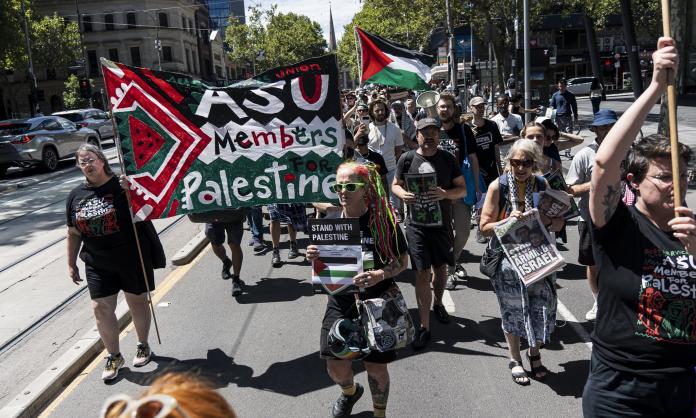It was nearly a year ago that Sally McManus, national secretary of the Australian Council of Trade Unions, launched the Change the Rules campaign. A television advertising campaign – said to be the biggest in a decade – was backed up by spirited rhetoric from union leaders calling on union members to “join a movement for change”.
Workplace meetings were organised across the country. In Melbourne, more than 1,600 packed into the Melbourne Town Hall in April for an all-union mass meeting of union delegates – the first of its kind since 2007. There, McManus, along with Victorian Trades Hall Council secretary Luke Hilakari and other key Victorian union leaders, called for sweeping changes to bargaining rules. They denounced economic inequality and vowed to fight job insecurity. This was followed in May by a street march of many tens of thousands of union members, with thousands more joining in smaller protests in other cities.
That was three months ago. There have been no further mass mobilisations. The ACTU has since dropped any pretence that Change the Rules is anything other than an electoral campaign to hoist Labor into power.
Since the initial protests and meetings, all energy has been directed towards electioneering. This was clearly demonstrated in the lead-up to five by-elections, “Super Saturday”, on 28 July. Hundreds of union organisers and activists were mobilised to doorknock for the Labor Party.
Tipping a union-busting government out of office is no bad thing. But if Labor does win the next federal election, what concrete commitments has it given to “change the rules” in favour of workers?
At the July ACTU Congress in Brisbane, Labor leader Bill Shorten did promise to reverse Fair Work’s recent cuts to penalty rates; place more restrictions on the use of labour hire, casualisation and fixed term contracts and abolish the Gestapo-like Australian Building and Construction Commission. He also promised to clamp down on sham agreements, which have increasingly been used to sidestep hard-won enterprise agreements and eviscerate wages and conditions, most recently the Esso gas workers at Longford.
However, many basic questions went unmentioned – the right to strike, for instance, and the right to bargain across industries or supply chains. And the record of Labor in government should give us no comfort that it will stand by even the limited promises it has made.
Though the ABCC was created by John Howard along with his hated WorkChoices attacks, Kevin Rudd and Julia Gillard maintained it for four years after Labor won office in 2007. Rudd also established the Fair Work Ombudsman, giving it the power to pursue unions and workers over industrial action, a power that has most recently been used against the Maritime Union of Australia and the National Union of Workers. In fact, the Labor Party was the architect of the system of rules the ACTU is now trying to change.
Speeches by ACTU secretary Sally McManus and newly elected president, Michele O’Neil, at the ACTU conference in Brisbane in July gave no indication that the union movement is readying itself for the fight to hold Labor to its word if the party wins government. The construction union circulated a leaflet among conference delegates detailing Labor’s sordid history (though not spelling out Shorten’s role in any of it), but no motions or speeches from the front even hinted that the union movement will need to tackle Labor, not simply electioneer for it.
The direction of the Change the Rules campaign from here will likely depend on the dynamics of the federal election campaign. The Liberal Party took a bad hit in the recent by-elections, and it now seems likely that there will be no election this year. This means the ACTU might announce another day of action. That would be positive, but won’t change the character of this campaign as fundamentally an electoral effort.
On what we’ve seen so far, there is no evidence that the Change the Rules campaign – even if successful in its own terms – will help rebuild Australia’s declining union movement. That will require a much more combative, class-struggle approach and the revival of widespread strikes – which will no doubt be condemned by Labor.
The numbers mobilised in April and May show that thousands of unionists will answer the call to fight if it’s made. The union leadership’s lack of interest in building for anything resembling a real stoush means that, while we may get a Labor government at the next election, our movement will still need a serious reorientation if it is to reverse its decline.









